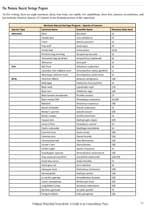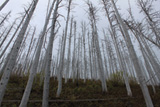Habitat Disturbances and Protections
It is impossible to precisely quantify the wildlife populations in the Flathead Watershed before European settlement. However, there is evidence that there have been massive declines in native species, as well as introductions of non-native species since settlement. Some of the most noticeable reductions in range occurred in large mammals, specifically bison, grizzly bears, and wolves.
Fish and wildlife are to varying degrees sensitive to changes and disturbances in their habitat. The diversity and integrity of their populations are therefore valuable indicators of the health and functionality of our watershed. A number of species in the Flathead Watershed are considered endangered, threatened, or candidate species as defined by the U.S. federal Endangered Species Act (ESA) of 1973 and the British Columbia Wildlife Act of 1966.
U.S. Fish and Wildlife Service Threatened and Endangered Animal Species of Montana
The Flathead Watershed has two mammals—grizzly bear and Canada lynx—currently listed as threatened, while one mammal—the gray wolf—was recently removed from listing after three decades and much controversy.
| US Fish & Wildlife Service Species Endangered, Threatened, Critical Habitat | |||
| Species Type | Common Name | Scientific Name | Status |
| Fish | Bull trout | Salvelinus confluentus | LT, Prop CH |
| Mammal | Grizzly bear | Ursus arctos horribilis | LT |
| Mammal | Canada lynx | Lynx canadensis | LT, CH |
| LT - Listed Threatened | |||
| CH - Designated Critical Habitat | |||
Figure 2.78: U.S. Montana Threatened and Endangered Species. Source: U.S. Fish and Wildlife Service
The Ministry of Sustainable Resource Management has identified eight mammals, three fish, one bird, and one amphibian as current wildlife at risk.
| SRMMP Species Status | |||
| Species Type | Common Name | Scientific Name | Species Status: Red-Endangered, Blue-Threatened |
| Mammals | Fisher | Martes pennanti | Blue |
| Grizzly bear | Ursus arctos | Blue | |
| Badger | Taxidea taxus | Red | |
| Wolverine | Gulo gulo | Blue | |
| Bighorn sheep | Ocis canadensis canadensis | Blue | |
| Redtailed chipmunk | Tamias rufucaudus ruficaudus | Red | |
| Southern red-backed Vole | Clethrionomys gapperi galei | Blue | |
| Least chipmunk | Tamias minimus orecetes | Blue | |
| Fish | Bull trout | Salvelinus confluentus | Blue |
| Westslope cutthroat trout | Oncorhynchus clarkii lewisi | Blue | |
| Mottled sculpin | Cotus bairdi hubbsi | Blue | |
| Birds | Williamson’s sapsucker | Sphyrapicus thyroideus nataliae | Red |
| Amphibians & Reptiles | Tailed frog | Ascaphus truel | Red |
Figure 2.80: Southern Rocky Mountain Management Plan Species. Source: B.C. Ministry of Sustainable Resource Management Wildlife at Risk
The Montana Natural Heritage Program (MNHP)
At this writing, there are eight mammals, thirty-four birds, one reptile, two amphibians, three fish, nineteen invertebrates, and ten mollusks listed as Species of Concern in the Montana portion of the watershed.
 |
| Click on icon above for a complete chart on MNHP's Species of Concern |
The Flathead Watershed has a unique wildlife community inhabiting richly diverse habitats. Grasslands, wetlands, riparian areas, and forests provide forage and shelter for bugs and birds, reptiles and amphibians, small mammals and ungulates, fish and carnivores. The watershed is as essential to birds that visit on their annual migrations as it is to the last assemblages of bison being protected from extinction. The variety, density, and completeness of species that move back and forth across the international boundary between British Columbia and northwestern Montana make this transboundary watershed a critical year-round range for many species. The varied and sometimes conflicting protections, management plans and tools make it a challenging region for transboundary species and the managers responsible for their protection. It will require the continued dedication of citizens, community leaders, scientists, and resource managers to maintain the health and diversity of this exceptional place.

